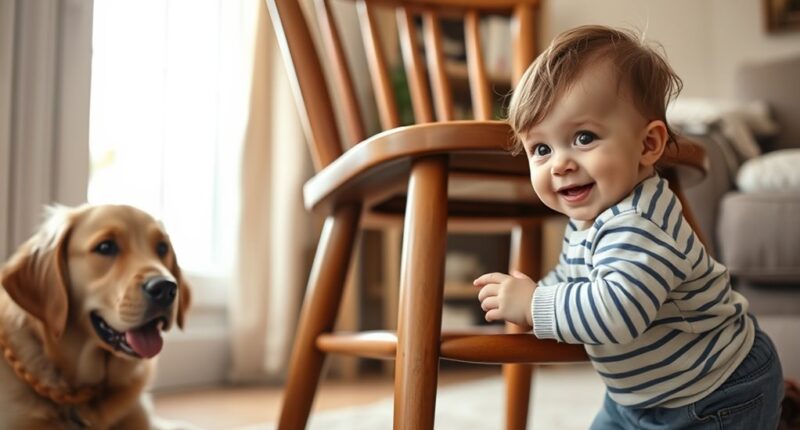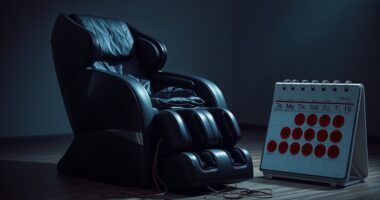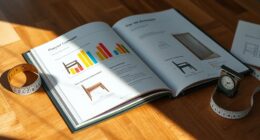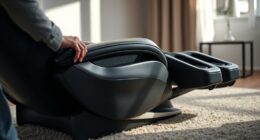To keep your pets and kids safe around chairs, identify common risks like tipping, sharp corners, or loose parts, and choose furniture with rounded edges, stable bases, and non-slip feet. Secure chairs with wall anchors and use childproofing devices like straps or gates. Regularly inspect and maintain chairs to catch wear or damage early. Implement safety rules and supervise children during play. Keep learning the best strategies to prevent accidents, starting with what’s next.
Key Takeaways
- Choose chairs with sturdy, non-slip bases and rounded edges to minimize tipping and injury risks for children and pets.
- Secure chairs to walls or floors with appropriate anti-tip devices and regularly inspect safety features.
- Use durable, easy-to-clean materials and perform routine maintenance to prevent damage, cracks, or loose parts.
- Implement childproofing measures like straps, brackets, and clear boundaries to prevent climbing and accidental tipping.
- Educate children on safe chair use and supervise play to foster lifelong safe habits around furniture.
Understanding the Common Risks Chairs Pose to Children and Pets
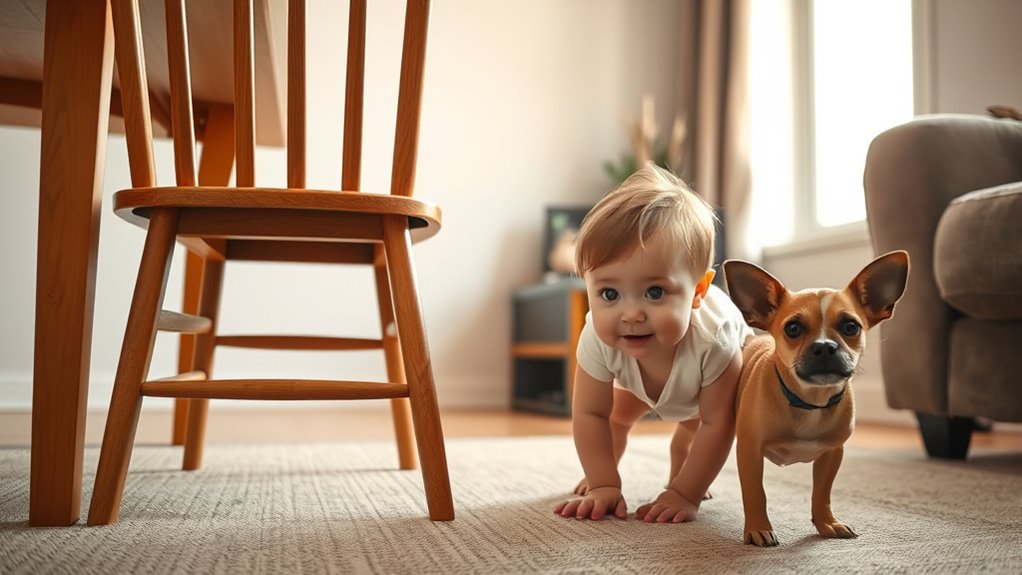
Chairs can pose several hazards to children and pets if you’re not careful. Poor chair ergonomics can lead to injuries if kids or pets fall or get caught between moving parts. Unstable or poorly designed furniture increases the risk of tipping over, which can cause painful accidents. Pets, especially curious cats and dogs, may chew on or claw furniture, damaging pet-friendly furniture and posing choking hazards if they swallow small parts. Sharp edges or gaps in chair frames can cause cuts or pinched fingers. Additionally, lightweight chairs might be easily pushed over, creating a tipping danger. Being aware of these risks helps you choose safer, more stable furniture options that protect your children and pets from harm while maintaining a comfortable space. Attention to detail in furniture design can significantly reduce these hazards and enhance overall safety.
How to Choose Safe Chairs for Homes With Kids and Animals
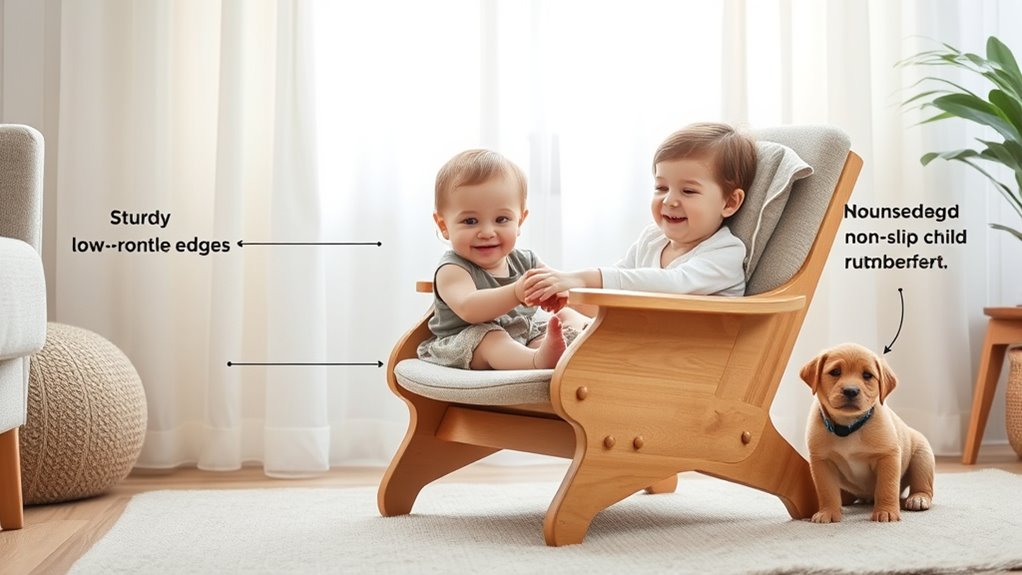
Choosing the right chairs for a home with kids and animals starts with prioritizing stability and safety features. Look for chairs with a sturdy base and non-slip pads to prevent tipping. When considering fabric choices, opt for durable, easy-to-clean materials like leather or tightly woven fabrics, which resist stains and are less likely to trap pet hair or crumbs. An ergonomic design is essential to ensure comfort and proper posture, reducing the risk of accidental falls or strain. Avoid chairs with sharp edges or unstable legs. Additionally, choose models with rounded corners and smooth surfaces to prevent injuries. Considering self-watering plant pots can inspire you to select furniture with features that promote safety and low maintenance, such as materials that are easy to clean and resistant to moisture. By selecting stable, well-designed chairs with suitable fabric choices, you create a safer environment for your kids and pets while maintaining style and functionality.
Tips for Securing Chairs to Prevent Tipping and Falling Incidents
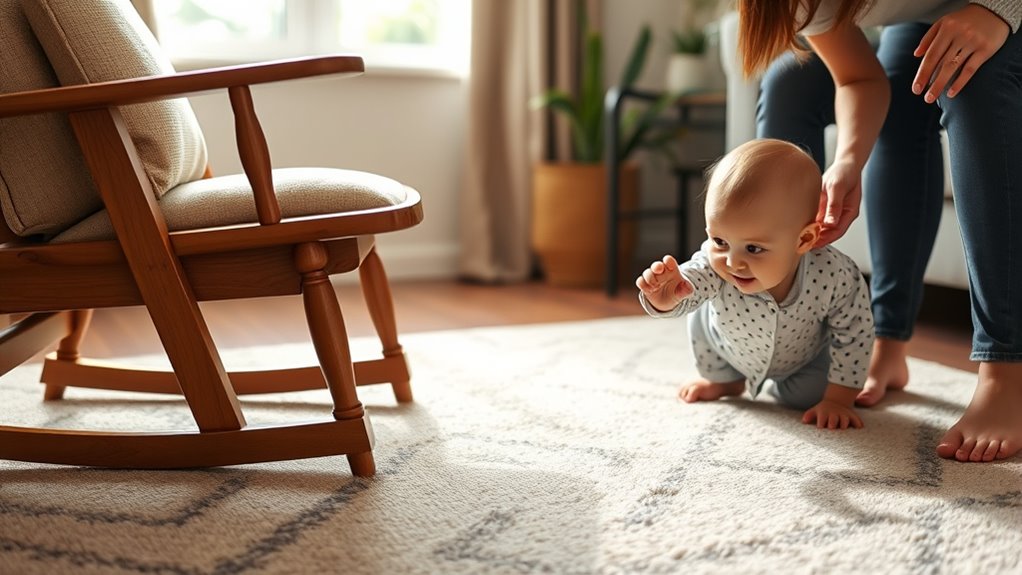
To keep your kids and pets safe, ensuring your chairs are secured properly is crucial. Using anti-tip devices and anchoring chairs to the wall can prevent accidents before they happen. Taking these simple steps makes your home safer for everyone. Incorporating principles of body awareness can also help you identify potential hazards and address them proactively.
Use Anti-tip Devices
Since children and pets can easily tip over unsecured chairs, installing anti-tip devices is an essential safety measure. These devices help prevent accidents and protect your loved ones. To effectively use anti-tip devices, consider these child proofing tips and pet safety considerations:
- Select the right anti-tip straps or brackets designed for your chair’s material and style.
- Secure the straps to the back or legs of the chair and attach them firmly to the wall or floor.
- Regularly check the devices for wear or looseness, replacing them as needed.
- Be aware of community engagement and share safety tips with family and neighbors to promote a safer environment.
Anchor Chairs Securely
Securing chairs firmly to the floor or wall is one of the most effective ways to prevent tipping and falling accidents. Use brackets, straps, or anti-slip pads to anchor heavy furniture, especially if it has lightweight chair upholstery or delicate furniture styling. Proper anchoring keeps chairs stable, reducing risks for pets and children. When choosing anchoring methods, consider the chair’s design and material to guarantee safety without compromising aesthetics. Here’s a quick overview:
| Method | Suitable for | Benefits |
|---|---|---|
| Wall straps | Lightweight chairs, furniture styling | Easy to install, discreet |
| Floor brackets | Heavy chairs, antique styles | Extra stability, durable |
| Anti-slip pads | Upholstered chairs, modern styling | Prevent sliding, protect floors |
Additionally, understanding the importance of contrast ratio can help in selecting projectors that ensure clear and vibrant images in your home cinema setup, enhancing overall viewing comfort. Secure your chairs today to keep everyone safe.
Recognizing Signs of Chair-Related Injuries in Children and Pets
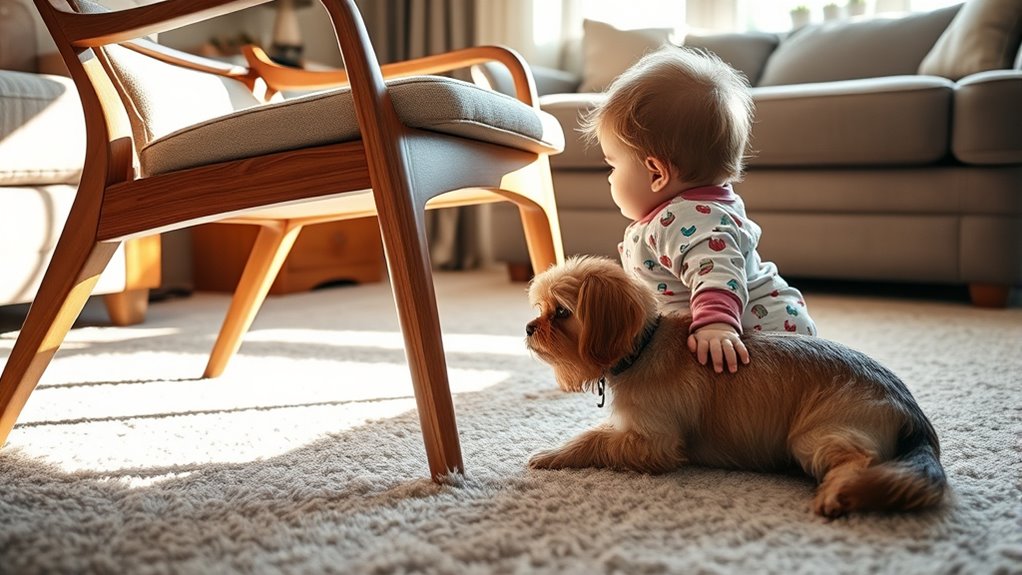
You should be alert for any unexplained bruises or swelling on your child or pet, as they can signal a recent chair-related injury. Pay attention to changes in behavior or activity levels, which might indicate discomfort or pain. Recognizing these signs early helps guarantee prompt care and prevents further harm. Being aware of trust issues that can develop in relationships may also help you stay attentive to your loved ones’ emotional well-being, ensuring any underlying concerns are addressed promptly.
Unexplained Bruises or Swelling
Unexplained bruises or swelling on children or pets can be warning signs of chair-related injuries that might otherwise go unnoticed. Recognizing these signs is crucial for effective child injury prevention and pet safety awareness. If you see bruising or swelling without a clear cause, inspect your furniture setup and supervise interactions closely. Additionally, ensuring that furniture is sturdy and free of sharp edges or unstable chair legs can help prevent injuries. Here are some key points:
- Check for sharp edges or unstable chair legs that could cause injuries.
- Monitor children and pets during play or sitting to prevent accidental bumps.
- Regularly review your environment for potential hazards that may lead to unnoticed bruising or swelling.
Addressing these signs promptly helps keep your kids and pets safe and prevents more serious injuries from occurring.
Changes in Behavior or Activity
Changes in a child’s or pet’s behavior or activity levels can be one of the earliest signs of chair-related injuries, especially when they suddenly become irritable, withdrawn, or lethargic. These behavioral changes and activity modifications often indicate underlying pain or discomfort. Watch for signs like decreased play, reluctance to move, or unusual clinginess.
| Child or Pet | Common Behavioral Changes | Possible Cause |
|---|---|---|
| Child | Irritability, withdrawal | Head or limb injury from falls |
| Pet | Lethargy, hiding | Pain from chair impact or fall |
| Child | Loss of appetite | Discomfort or injury |
| Pet | Reduced activity | Pain or trauma |
| Child/Pet | Sudden aggression or fear | Trauma or distress |
Childproofing Strategies for Dining and Desk Chairs
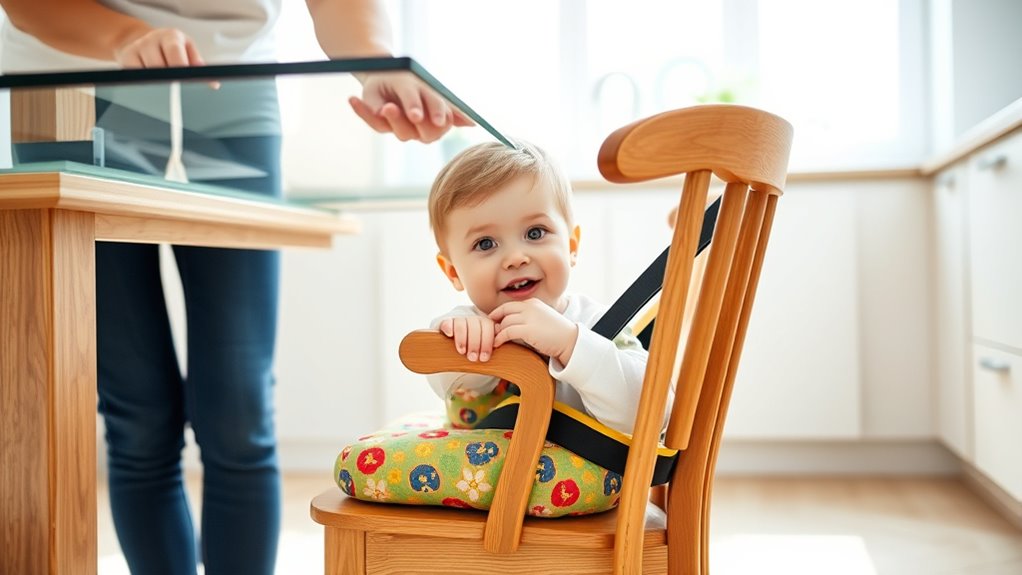
Childproofing dining and desk chairs is essential to prevent accidents and guarantee your child’s safety. Start by adjusting chair height to ensure your child can’t easily climb or fall. Lowering the seat reduces the risk of falls and makes it safer for little ones. Next, check upholstery safety—opt for chairs with non-toxic, durable fabrics that are easy to clean and free from choking hazards. Finally, consider adding anti-slip pads to the legs to prevent sliding and tipping. Using materials that promote environmental sustainability can also contribute to a healthier home environment. Here are key strategies: 1. Adjust chair height to match your child’s size. 2. Choose upholstery that is safe, non-toxic, and secure. 3. Use anti-slip pads for added stability. Implementing these tips creates a safer environment and minimizes accident risks around dining and desk chairs.
Creating a Safe Play Area Free From Chair Hazards
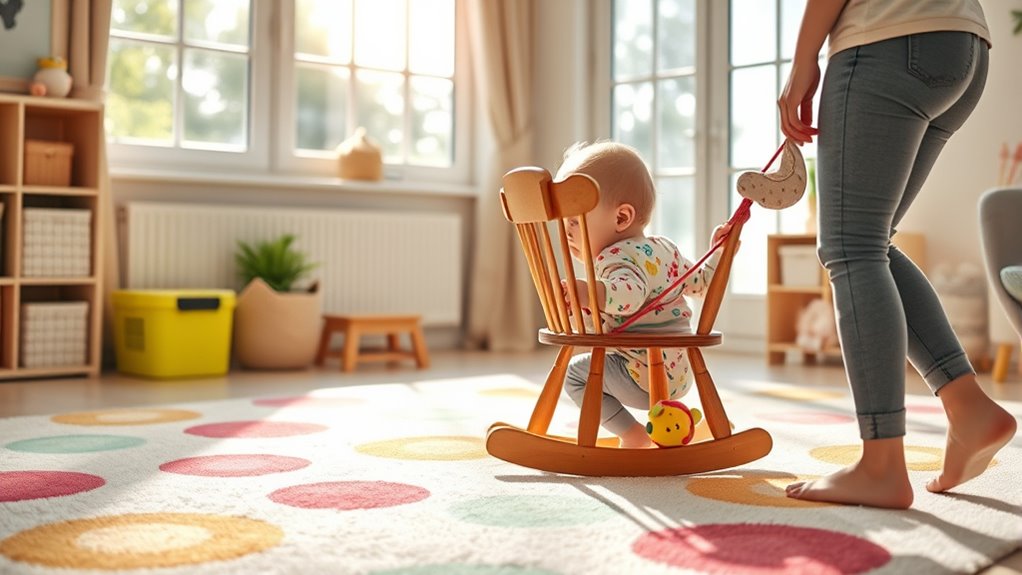
Creating a play area free from chair hazards starts with careful planning and supervision. Begin by selecting furniture with ergonomic design features that prioritize safety, such as rounded edges and stable bases. Avoid chairs with sharp corners or unstable legs that could tip over when children or pets climb or pull on them. Incorporate decorative aesthetics that blend seamlessly with your space while maintaining safety, like using furniture covers or soft padding in high-risk areas. Keep pathways clear of chairs and other furniture that could cause trips or falls. Regularly inspect chairs for stability and damage. By combining thoughtful design with vigilant supervision, you create an environment where play is safe, and hazards are minimized—allowing your kids and pets to enjoy their space worry-free.
When and How to Use Safety Devices Like Chair Anchors and Guards

To guarantee your chairs stay secure and prevent tipping accidents, you should use safety devices like chair anchors and guards whenever there’s a risk of instability. These devices help you comply with chair safety regulations and accommodate ergonomic chair design, especially in homes with kids or pets. Knowing when and how to install them assures maximum protection. A helpful tip is to consider expert advice on proper installation techniques to ensure the safety devices function effectively. 1. Assess stability—if your chair wobbles or leans, it’s time to install anchors or guards. 2. Follow manufacturer instructions for proper installation to ensure effectiveness. 3. Regularly check and tighten anchors to maintain safety over time.
Use safety devices like anchors and guards to keep chairs secure and prevent tipping accidents.
Using these safety devices reduces the risk of accidents, making your home safer for everyone. Proper implementation aligns with safety standards and promotes a secure environment around chairs.
Teaching Kids About Safe Chair Use and Behavior

Once safety devices like chair anchors and guards are in place, teaching kids how to use chairs responsibly becomes the next essential step. Many chair safety myths can lead to careless behavior, so it’s important to clarify what’s safe and what’s not. Use child supervision techniques to set clear boundaries and consistently reinforce rules. Explain why climbing or standing on chairs is dangerous, making safety instructions simple and age-appropriate. Encourage your kids to sit properly and avoid rough play around chairs. Regularly remind them of safety expectations, and model responsible behavior yourself. You can also introduce childproofing tools to help create a safer environment and support your teaching efforts. By combining active supervision with honest communication, you’ll help your children understand safe chair use, reducing accidents and fostering lifelong safe habits around furniture.
Material and Design Features That Enhance Chair Safety
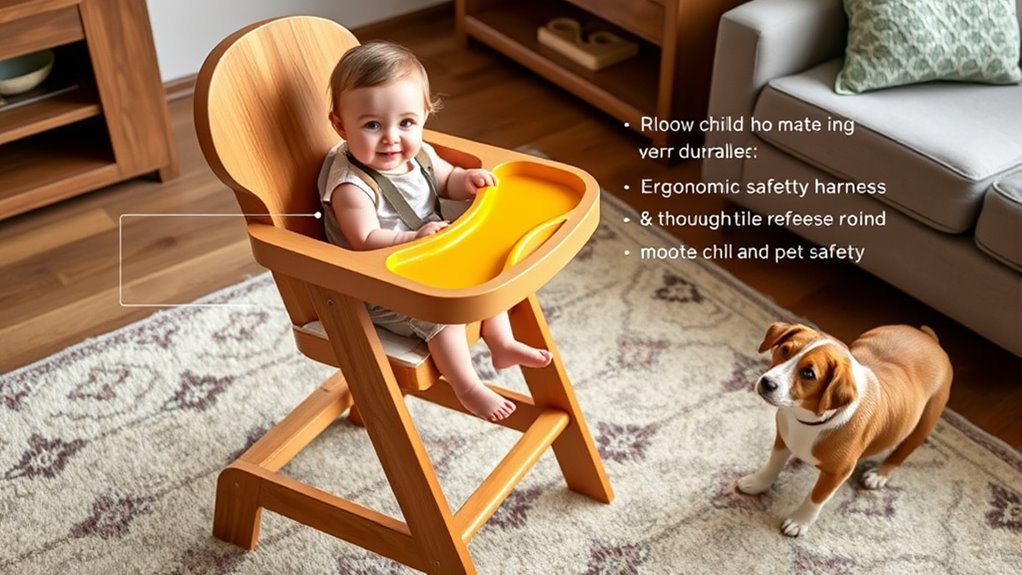
Choosing chairs with safety-enhancing materials and thoughtful design features can substantially reduce the risk of accidents. Focus on material safety by selecting non-toxic, durable materials that withstand wear and tear. An ergonomic design ensures comfort and stability, reducing the chance of tipping or slipping. To maximize safety, consider these features:
- Rounded edges and smooth surfaces to prevent injuries.
- Non-slip feet or pads for enhanced stability.
- Lightweight yet sturdy frames for easy handling and reduced tipping risk.
Regular Maintenance and Inspection to Minimize Risks

To keep your chairs safe for pets and children, you need to perform regular maintenance and inspections. Make sure to schedule routine checks to catch any loose parts or damage early. Tighten or replace worn components immediately to prevent accidents.
Schedule Routine Checks
Regularly inspecting and maintaining chairs is essential to guarantee the safety of both pets and children. By scheduling routine checks, you can catch potential hazards early, especially concerning chair height and chair material. Over time, chair legs may loosen, or the material may degrade, creating risks.
To stay proactive, consider these steps:
- Examine chair height to ensure stability and prevent tipping hazards.
- Check chair material for cracks, splinters, or wear that could harm sensitive skin or paws.
- Test for loose parts or wobbling, tightening or replacing components as needed.
Perform these inspections weekly or after significant use to minimize risks. Regular checks keep your furniture safe, reducing accidents and ensuring peace of mind for your family and pets.
Tighten Loose Parts
Ensuring your chairs remain safe for pets and children requires you to actively tighten loose parts during routine inspections. Check the chair’s structure regularly, paying attention to the chair height adjustments and joints. Loose screws, bolts, or fasteners can compromise stability, increasing the risk of tipping or collapse. The material’s durability plays a role; weaker or worn components are more prone to loosening over time. Use the appropriate tools to tighten any loose hardware securely, avoiding overtightening that could damage the material. Regular maintenance prevents small issues from escalating into safety hazards, especially if your kids or pets like to climb or tug on furniture. Staying proactive with tightening loose parts helps ensure your chairs stay sturdy and safe for everyone.
Replace Worn Components
Replacing worn components is essential for maintaining the safety and stability of your chairs. Over time, chair material can degrade, and ergonomic design features may weaken, increasing safety risks for pets and children. Regular inspections help you identify parts that need replacement before accidents happen.
Consider these steps:
- Check the chair material for tears, cracks, or fraying, especially on the seat and backrest.
- Inspect joints and moving parts for looseness or rust, ensuring stability.
- Replace worn or damaged components promptly to maintain the chair’s ergonomic design and prevent falls or injuries.
Frequently Asked Questions
Are There Age-Specific Chair Safety Guidelines for Children?
Yes, there are age-specific chair safety guidelines for children. You should follow child proofing tips and use age-appropriate recommendations to guarantee safety. For infants, secure chairs with straps and avoid placing them near edges. Toddlers need stable, low chairs with guardrails. As children grow, teach them safe sitting habits and supervise their use. Adjust safety measures based on your child’s age to prevent accidents and promote safe chair use.
How Do I Select Pet-Friendly Chairs Without Compromising Safety?
Think of selecting pet-friendly chairs as finding the perfect dance partner. You want furniture that offers pet comfort without sacrificing style. Look for chairs with rounded edges, sturdy frames, and slip-resistant legs to keep pets safe and secure. Choose designs that blend seamlessly with your decor, so aesthetics don’t suffer. By prioritizing durability and safety features, you create a space that’s both beautiful and pet-friendly, giving your furry friends a cozy, worry-free spot.
What Are the Best Materials for Minimizing Injury Risk?
You should choose chairs made from materials that prioritize material safety, such as rounded edges and non-toxic, durable surfaces like silicone, soft plastics, or treated wood. These materials help with injury prevention by reducing sharp edges and minimizing splinter risks. Avoid flimsy or brittle materials that can break easily. Opting for sturdy, smooth, and non-toxic options guarantees your pet and child’s safety while preventing injuries around chairs.
Can DIY Modifications Improve Chair Safety Effectively?
Yes, DIY upgrades can effectively improve chair safety by adding customization options tailored to your needs. You can reinforce weak spots, install safety straps, or add non-slip pads to prevent slips and falls. These modifications allow you to customize your chair for pet and child safety, making it more secure. Just guarantee you use appropriate materials and follow safety guidelines to avoid creating new hazards during the process.
How Often Should Safety Devices Like Anchors Be Checked or Replaced?
Think of safety devices like anchors as your home’s security guards; you need to check them regularly. You should inspect and tighten your anchors monthly, more often if you notice any wear or after a product recall. Replace them if they’re damaged or no longer hold securely. Always verify that your anchors meet safety certification standards, ensuring they keep your kids and pets safe and are up-to-date with the latest safety guidelines.
Conclusion
By staying vigilant and choosing thoughtfully designed chairs, you create a safe haven where your children and pets can explore comfortably. Imagine a cozy corner free of wobbling legs and sharp edges, where every seat is anchored securely, and every surface invites confidence. With regular checks and clear boundaries, you foster an environment where safety blossoms like a well-tended garden—peaceful, secure, and inviting for everyone who sits down.
